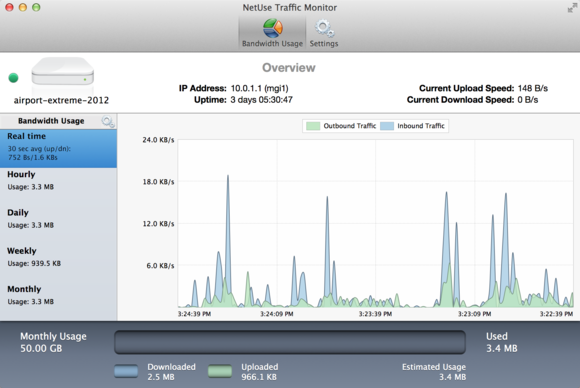Download Netuse Traffic Monitor For Mac
Please test your hardware setup with our free SNMP test app first. Contact us if you have questions. NetUse is the best way to monitor your network traffic on the Mac.
Utilizing the SNMP feature of any modern Internet router or gateway, NetUse monitors and collects real-time Internet usage stats for all the computers in your home or office that share an Internet connection. If you have a traffic cap on your Internet usage, NetUse will help make sure you don’t exceed your limits. Set your billing date and a monthly traffic allowance and NetUse will accurately show how much bandwidth you consume. Features:.

Monthly usage data estimation. Warnings and notifications system. Status bar and dock icons with live usage stats. Doesn't require to be run 24/7. Full SNMP Support including version 1, 2c and 3. Works with any SNMP-enabled router.
Real-time traffic monitor. Logs and plots your whole network usage. Elegant and simple User Interface. Auto configuration and assistant wizard. Configurable billing date and monthly usage allowance (cap) NetUse requires the SNMP feature on your router or gateway to be enabled.
Please check your hardware specifications to ensure that it supports SNMP before trying NetUse. Or download our free SNMP test utility.


I believe that Rubbernet is exactly what you are looking for. The only downside is that Rubbernet cannot distinguish between LAN traffic and WAN traffic. It sounds like you are looking at one computer, so that shouldn't be an issue.
There is a demo available on their website, or you can buy it from the for US$25, which seems to be a pretty good deal since they want € 29.99 (about US$42) for a single user copy or € 49.99 (almost $69) for a 'family pack' if you buy through their website. (Hat tip to for bringing it to my attention a few months ago.) If you want something cheaper, might suit you too. You can try (1) in the Terminal. It is pre-installed, and refreshes every few seconds to provide a dashboard of all open network connections with their usage.
Download Netuse Traffic Monitor For Mac Pro
Better than lsof since it shows the usage data too. $ nettop Then hit 'd' and look for odd-looking entries or entries with consistently large traffic in the 'bytes in' or 'bytes out' column.
Download Netuse Traffic Monitor For Mac
The 'd' instructs nettop to only show differences in each screen refresh. Practical usage notes: If you don't recognize the process name, Google it. If you don't want the process around, get the pid (the number next to the process name in nettop), and kill it with kill -9. If that doesn't solve it, find out if you can uninstall the process.
If you're interested in what the process is transmitting over the network, use the client port number for that particular connection (e.g. '53133' from 10.0.0.1:53133-74.125.68.100:80) to run a (1) to see the data in the packets being exchanged: sudo tcpdump -nnvvXSs 1514 port 53133 If you're interested in the destination the process is talking to, but the destination IP address doesn't have a reverse DNS hostname (like in the previous example), then try visiting that IP address in a web browser as, click the broken lock icon in the address bar, and view the certificate details to find out which domain is served there (.google.com in this case). This won't work if SSL port 443 isn't open on the destination. First, most ISPs can tell you how much bandwidth you're using. It sounds like you had a technician that either didn't know much or was just trying to shoo you away. Second, the only way to steal bandwidth is if you have a wireless network that isn't properly secured.
This means you'll need to monitor bandwidth from your wireless router, not your laptop/desktop. If you do have a wireless router, I would just change the SSID and secure it with a new (hard to guess) password.
That will immediately cut-off anyone that could be leaching off your network. It's very simple to do compared to trying to monitor your bandwidth usage. If you're looking for a way to monitor your Internet usage as a whole, including all devices connected to it, you might want to check out. It uses SNMP or UPnP to talk to routers and computers that can given you a real-time and historical view of bandwidth consumption and activity.
This lets you monitor usage of your Internet connection as a whole, not just the computer you're on - useful if you have a few devices on your network. Knowing your exact network activity or activity over time can be very helpful for diagnosing ISP issues. You can also monitor individual devices (if they support SNMP) which can be good for tracking down excessive usage.
Heads up: I'm the developer.
Top Articles
- Creative Sound Blaster Es1371 Driver For Mac
- Fitbit Connect For Mac
- Kvr: Eiosis Releases Edeesser For Mac
- Network Diagram Tool For Mac
- Black Friday Brief For Mac
- Mcculloch 110208 Chainsaw Flat Head Screw For Mac
- Positivo Pos-ag31ap Driver For Mac
- Flume 2.8.5.3 Free Download For Mac
- Paceap Drivers For Mac
- Sony Vgp Bms55 Drivers For Mac
- Ue Mini Boom Drivers For Mac
- Apogee Element 24 10x12 Thunderbolt Audio I/o Box For Mac
- Komponen Sketchup Download For Mac
- General Electric Minicam Pro 98756 Driver For Mac
- Acrobat Xi Pro For Mac
- Robert Alai, Hsc On Twitter: Looking For Mac





